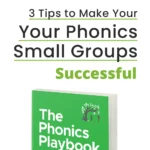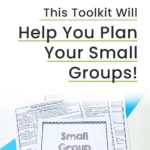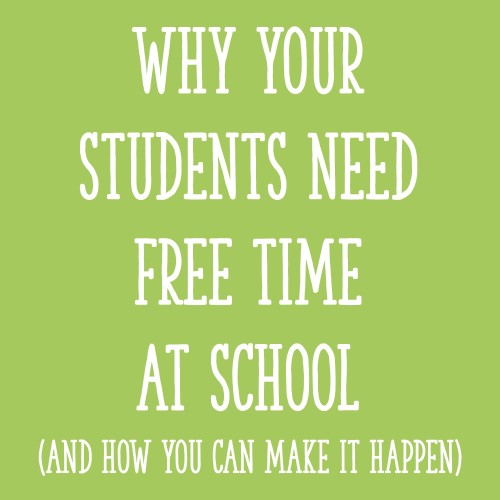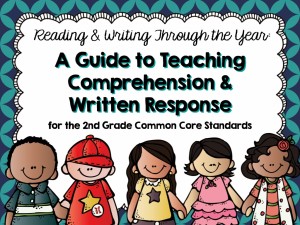Isn’t “whole group vs. small group instruction” a constant debate that’s always going on in a teacher’s mind?! You have students with a wide range of needs. Yet you only have so many minutes in the day. What’s the best way to reach all your students?
In this post, I go into detail about how I balance whole and small group instruction when teaching phonological awareness, phonics, high frequency words, fluency, comprehension, and vocabulary. There are 3 sections: Kindergarten, 1st grade, and 2nd grade, so feel free to scroll to the part that’s most applicable to you!
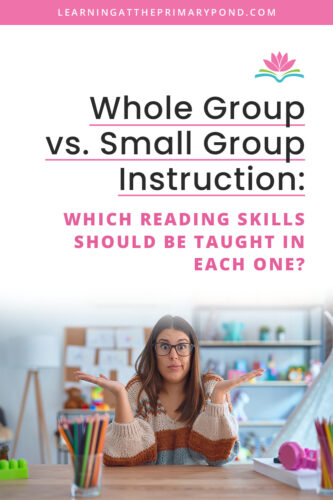
>>Kindergarten<<
Phonological Awareness
It makes sense to practice phonological awareness in a whole group setting on a daily basis. All students benefit from working on phonological awareness skills (like rhyming, blending, and segmenting), and it’s easy to sneak in a few minutes of practice between activities and/or with your morning meeting.
That said, research has shown that small group phonological awareness instruction is very effective. Working on phonological awareness skills in a small group setting allows you to monitor students’ progress more closely. You can actually hear individual students practice skills like blending and segmenting, and you can provide corrective feedback as needed.
Plus, if certain students need to revisit skills that you’ve moved on from in whole group, you can continue practicing them in small groups with the students who need it. Additionally, you can challenge students with more advanced skills if needed!
In a nutshell, I prefer a combination for phonological awareness: we work on it on a daily basis in a whole group setting, and then also spend a couple of minutes on it during small group. As students begin to read and spell simple words, that small group time focuses more on blending and segmenting in the context of reading and spelling.
Phonics
In Kindergarten, I always begin the school year by teaching the alphabet in a whole group setting. We work on letter names, letter sounds, and letter formation.
Some students will begin the year knowing many letters, so some of this instruction may feel redundant. However, there are ways to differentiate your alphabet instruction to make it relevant to all learners! If I happened to have a class of students who know most, if not all, of their letter sounds and letter names already, I would progress through the alphabet more quickly.
After I’ve taught the alphabet, I assess my students on their letter knowledge. Based upon the outcomes of that assessment, I can decide if I want to:
- Continue with plenty of whole group instruction, supplemented by some small group work on phonics OR
- Transition to “just a dash” of whole group instruction and review, with most of my phonics instruction happening in small groups.
I would only choose Option #2 if I truly have a very large range of needs in my class. Otherwise, Option #1 is usually easiest to implement in Kindergarten.
High Frequency Words
Even though I consider high frequency word instruction to be part of my phonics instruction, I separated it out here because I prefer to teach high frequency words in a whole group setting (not small group).
It can be helpful to review words or perhaps teach a few additional words to students in a small group. However, for practicality’s sake, it’s easiest if everyone is working on the same set of words. Otherwise, you’re struggling to remember which group knows which words!
That said, there’s certainly nothing wrong with teaching high frequency words in a small group setting! I’m careful to wait until students know some letter sounds before I introduce high frequency words, and that may happen for different students at different times.
Fluency
Working on reading fluency in Kindergarten looks a bit different than it does in other grade levels! When students are learning their sounds and beginning to read simple CVC words, these are the building blocks that will (eventually) lead to them becoming fluent readers. So when you’re teaching phonics and phonemic awareness, you’re also working on fluency!
In a whole group setting, I also do some work with fluency in shared reading. To help my students learn print concepts like one-to-one tracking and reading left to right, I love using big books (especially at the beginning of the school year – once students can decode a bit more, I focus more on modeling decoding with books closer to their level).
Those big books often present wonderful opportunities to model and have students practice skills like: reading with expression, changing your voice for the ending punctuation mark, pausing at periods, etc. I often say, “Listen while I (fill in fluency skill here)” and then model reading a page or a sentence. Then, I invite students to reread the page or sentence with me to practice the skill I just modeled.
Last but not least, something to remember with fluency is that you are modeling it any time you read-aloud to students. Yay read-alouds!
Comprehension
Comprehension is another skill set that I primarily work on in a whole group setting. Students in Kindergarten typically cannot decode very challenging books, so if I want to engage them in challenging thinking and comprehension skills, it’s best if I do the reading for them (like in a read-aloud).
However, this is not to say that I never work on comprehension in a small group setting! Every time I have students read a text, I have them retell it, and I ask them questions about it. Even if students aren’t reading quite yet, my small groups may include a little shared reading or read-aloud so we can discuss a text and build comprehension.
Vocabulary
Vocabulary is often the forgotten member of the literacy family, but it’s SO important! You can’t understand a text unless you can understand the words, and we need to build our Kindergarteners’ vocabularies and oral language skills so that when they can decode more challenging texts on their own, they can actually understand them.
I prefer to rely on whole group instruction for explicit teaching of vocabulary words (for practicality’s sake). Of course, we do talk about words and build oral language in a small group setting, too – but it tends to be more incidental and related to texts we are reading.
>>1st Grade<<
Phonological Awareness
Just like with Kindergarten students, it’s helpful to practice phonological awareness in a whole group setting on a daily basis with first graders. You can spend 10-15 minutes per day on these activities, but it doesn’t have to be all at once. I prefer to break up my instruction and fit it in between activities.
As I mentioned with Kindergarten, research has shown that small group phonological awareness instruction is very effective. You can monitor students’ progress more closely and more accurately hear individual students practice skills so you can provide corrective feedback.
Additionally, if certain students need to revisit skills that you’ve moved on from in whole group, you can continue practicing them in small groups with the students who need it. Your lower readers will need more time practicing phonological awareness (specifically phonemic awareness) skills, and you can do that when you meet with them in small groups.
Just like with Kindergarten, I prefer a combination for phonological awareness in first grade: we work on it on a daily basis in a whole group setting, and then also spend a minute or so on it during small group. As students’ abilities grow, we tend to do more blending and segmenting in the context of reading and spelling.
Phonics
In first grade, I teach phonics in both whole group and small group. The amount of instruction that I provide in each one really depends on students’ needs.
If most of my class is more or less on the same page as far as their phonics knowledge (use this free assessment to determine that), I introduce new skills in a whole group setting. Students may have differentiated practice activities, and I further differentiate in small groups.
On the other hand, if my class is really all over the place in terms of phonics knowledge, I introduce new skills in a small group setting, and each small group might be at a different point in our scope and sequence. I still do a bit of review with the entire class, and we absolutely discuss phonics in the context of reading when relevant.
The second scenario (introducing new skills in a small group setting) can certainly be challenging. First graders need phonics instruction on a daily basis, and it can be hard to find time to meet with all of your small groups every day.
Therefore, the first scenario (instruction happening in a whole group setting) is usually easiest to implement – and you can absolutely supplement that with small group work, too.
High Frequency Words
Just like in Kindergarten, I prefer to rely on whole group for most of my high frequency word instruction, for practicality’s sake. In small group, I might work on easier words with lower groups of students, or occasionally teach advanced students a new word.
Fluency
When you’re teaching phonemic awareness, phonics, and high frequency words, you’re helping students build fluency!
I work on other fluency-related skills (reading with expression, changing your voice for the ending punctuation mark, pausing at periods, reading in smooth phrases, etc.) in both whole group and small group settings. It’s easiest to do explicit instruction on these skills when students can see the actual text, like in shared reading, close reading, or small group. You can model a skill and then have students practice it right in the text.
You’re also modeling fluency every time you read aloud to students!
Comprehension
Just like with Kindergarten, a lot of comprehension work in first grade happens in whole group, simply because students typically can’t read texts that are very challenging comprehension-wise. I have whole group mini-lessons with explicit instruction, and then we also work on comprehension in small group as it relates to the texts students are reading.
Vocabulary
I rely on whole group instruction for explicit vocabulary instruction in 1st grade, simply because that’s the most efficient way to teach words (and vocabulary instruction doesn’t usually require as much differentiation).
Of course, in small group, we also talk about words in the texts that students are reading.
>>2nd Grade<<
Phonological Awareness
In second grade, the amount of phonological awareness instruction that you do will really depend on students’ needs. Many second graders, if they’ve had strong phonological awareness instruction in Kindergarten and 1st grade, may come in already having mastered essential skills.
In From Sounds to Spelling (R), our phonics program, teachers do a little more with phonological awareness at the beginning of the school year and gradually taper off (this can be done in a whole group setting). Then, students tend to practice phonological awareness in the context of reading and spelling: blending sounds together and segmenting words before spelling them.
Students who struggle with reading often benefit from additional phonological awareness (specifically, phonemic awareness) practice in a small group setting. These students will need more practice and more repetition than other students do. Small group provides a great opportunity for this.
Phonics
Just like in first grade, I teach phonics in both whole group and small group in second grade. The amount of instruction that I provide in each one depends on students’ needs.
If my students have similar-ish levels of phonics knowledge (use this free assessment to figure out if that’s the case for your students), I introduce new skills in a whole group setting. Students may have differentiated practice activities, and I reinforce and review skills in small groups. Students who struggle with phonics get more instructional time in small group than my more fluent readers.
However, if my students have very diverse needs in terms of phonics, I introduce new skills in a small group setting, and each small group might be at a different point in our scope and sequence. I still do a bit of review with the entire class, and we discuss phonics in the context of reading, when relevant.
The second option (introducing new skills in a small group setting) can be challenging on a practical level. Second graders need phonics instruction on a daily basis, and it can be difficult to find time to meet with all of your small groups every day.
Therefore, the first scenario (instruction happening in a whole group setting) is usually easiest to implement – and you can supplement that with small group work, too.
High Frequency Words
Just like in Kindergarten and first grade, I rely on whole group for most of my high frequency word instruction (for efficiency). In small group, I review easier words with lower groups of students who need it.
Fluency
We can help second graders improve their fluency by growing those “building blocks” of phonemic awareness, phonics, and high frequency words. Reading words and texts repeatedly is a great fluency-builder!
I work on other fluency-related skills (for example, reading with expression, changing your voice for the ending punctuation mark, pausing at periods, reading in smooth phrases) in both whole group and small group. It’s easiest to explicitly teach these skills when students can see the actual text, like in shared reading, close reading, or small group. You can model a skill and then have students practice it right there in the text.
You’re also modeling fluency every time you read aloud to students!
Comprehension
In second grade, comprehension work happens in both whole group and small group instruction. Both are important! In whole group, students can access more challenging text, because often you’re reading it aloud to them. When you read aloud and work on comprehension, you’re building the skills that students will eventually be able to use on their own once they can read more challenging texts.
Small group comprehension work is important, too! Students need to discuss and work on comprehending the texts that they read on their own, and you can provide this support in a small group setting.
Vocabulary
I use whole group instruction for explicit vocabulary instruction in second grade, because that’s the most efficient way to teach words (and vocabulary instruction doesn’t usually require as much differentiation).
In small group, we also talk about words in the texts that students are reading.
Conclusion
That was a lot of information, but I hope it was helpful to you!
If you’d like to see some examples and get some free activities to use in your small group instruction, grab my free “Small Group In a Snap” downloadables at this link.
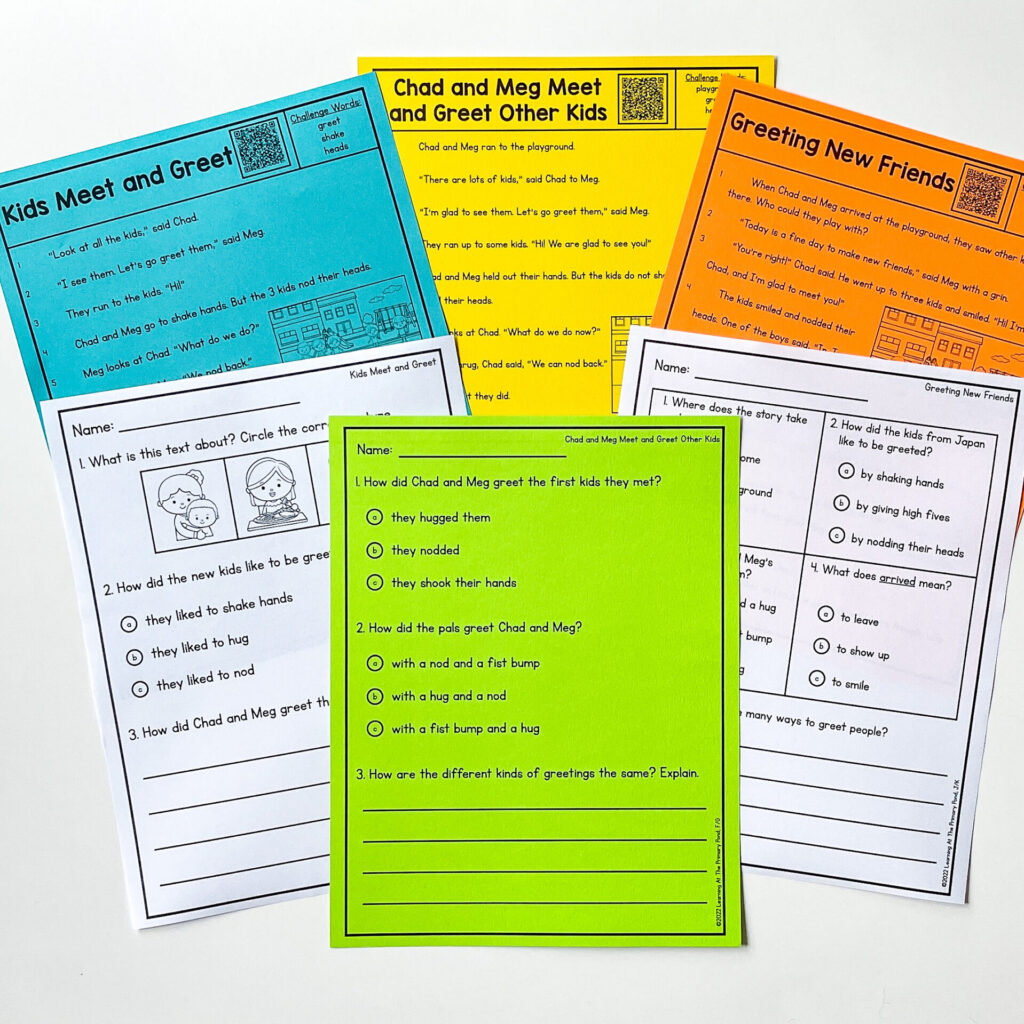
Happy teaching!

